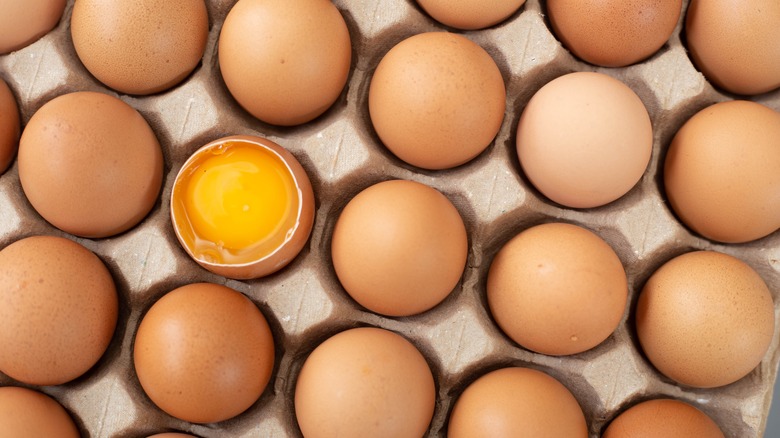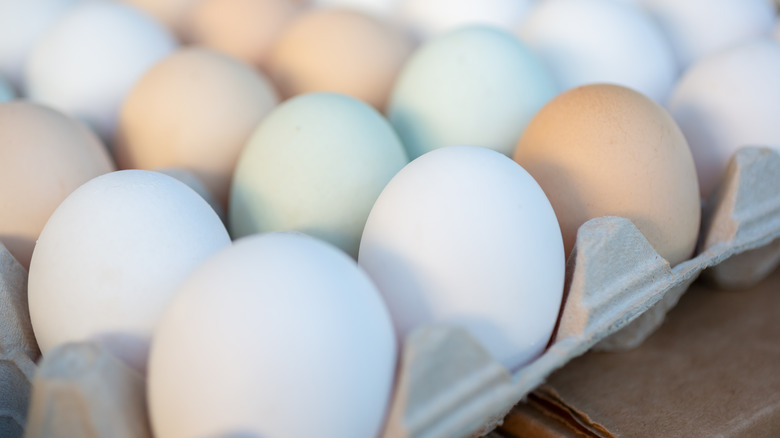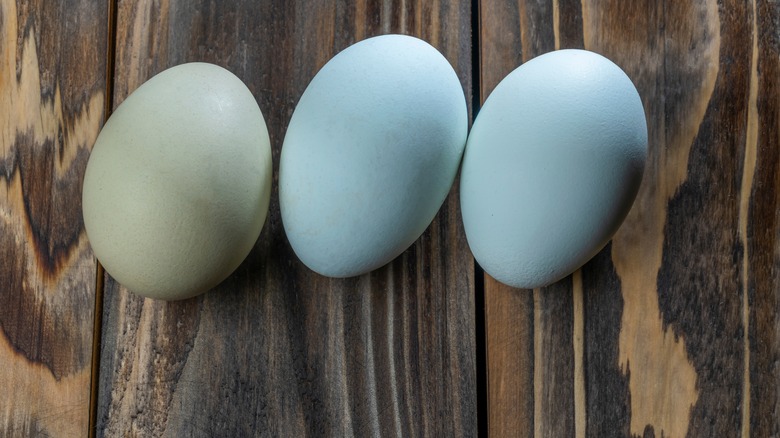For Top-Tier Eggs, Look For One Specific Label At The Grocery Store
When you're in the grocery store shopping for eggs, you might notice odd labels peppered across the rows and rows of eggs. They use descriptors like "cage-free," "farm-raised," or "organic." Despite all these colorful labels, these eggs often don't look like anything special — they appear to be ordinary white or brown eggs. Do those labels actually mean anything, or are they just minorly different ways of saying the same thing: These eggs are okay to consume?
Although you may not be able to tell a cage-free egg from an ordinary egg by shape or shell color alone, the difference is real, and lies in how the egg looks and tastes. Labels like "cage-free" and "pasture-raised" indicate how the hen was raised, and how those living conditions affect the egg. For example, when compared to your average grocery store egg, a farm-fresh egg will have a bright orange yolk and a richer flavor. A good comparison would be vegetables grown in an industrial greenhouse compared to ones grown on a farm with fresh fertilizer and no pesticides. There may not be too much of a difference on the outside, but you will probably note an enormous difference in taste once you take a bite.
But what about those grades that you may see on your egg carton? What makes the difference between Grade AA eggs and Grade A eggs? Which grade is the superior one? We're here with all the answers.
Grade AA is the best egg grade
Like most products, eggs have to undergo a series of rigorous tests before they're shipped out to the consumer. They're carefully examined based on a variety of different factors, such as the exterior (how smooth the shell is, whether there are cracks or chips, the shape of the egg) and the interior (done through a process called "candling," to avoid cracking). Based on these factors, eggs are given one of three grades: AA, A, and B.
Grade AA is considered to be the best of all these grades. AA eggs are known for having flawless shells with bright yolks and thick egg whites. They're good for most purposes, but are usually reserved for frying or poaching. The near-perfect appearance of these eggs is critically important, as their vivid yolks and clean whites make them an attractive sight at any breakfast table. They are, in short, the gold standard of eggs.
There's just one problem: Grade AA eggs are usually somewhat harder to find than the ordinary eggs you see in your local grocery store. While some might luck into finding them based on location, you may have to find a farmer or other type of wholesale egg dealer if you want to get Grade AA eggs.
What about grade A eggs?
If Grade AA eggs are supposed to the best eggs out there, that would imply Grade A eggs aren't as good, right? While it is true Grade A eggs aren't as revered as Grade AA, this doesn't mean Grade A eggs are bad in any way, shape, or form.
Grade A eggs' exteriors might be as flawless as those of Grade AA eggs, but they don't have the same picture-perfect interior qualities. Their yolks may not be as bright, nor their egg whites as well-textured. But they're still perfectly fine to eat, and can be used in all manner of cooking. Another bonus — if you choose to see it as a bonus, that is — is that the lower quality of Grade A eggs means you don't have to worry about preserving the eggs' texture or appearance. You're free to scramble, fry, poach, or boil your Grade A eggs as much as you want. In contrast, there's a certain pressure to baby Grade AA eggs, in the hopes of preserving their extra-fine looks.
Another bonus about using Grade A eggs is that, unlike Grade AA eggs, they can be found at most grocery stores. While you may have to do some running around to find Grade AA eggs, you can easily visit your local shop and grab some Grade A eggs without much trouble.


